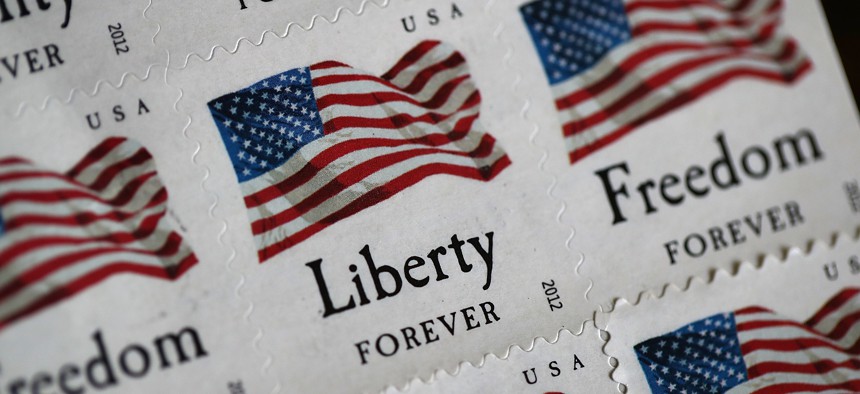
USPS officials plan to raise the price of postage stamps to $0.68 in January, pending approval from the Postal Regulatory Commission. Justin Sullivan / Getty Images
USPS looks to raise rates for fifth time under DeJoy
The higher rates are helping to offset accelerated declines in mail usage.
The U.S. Postal Service plans to increase the price of a stamp to $0.68 in January, part of a 2% overall increase from current mail rates.
The hike is the full amount authorized under the mailing agency’s rate-setting authority and would mark the fifth price increase under Postmaster General Louis DeJoy. Prices for marketing mail, periodicals and packages will all increase by around the same rate.
If the latest hike—set to go into effect Jan. 21, 2024—goes through, the price of a stamp will have increased by 24% in the more than three years since DeJoy took office. That roughly equals the rate of increase USPS oversaw in the preceding 11-year period.
The USPS board of governors has signed off on the price hike, but it must still receive final approval from the Postal Regulatory Commission. The commission allowed for the higher increases in 2020 and DeJoy has tapped into the authority on nearly every allowable occasion, calling them a key part of his plan to allow USPS to find firmer financial footing. Approval of the increases will amount to a simple checking of the math to ensure postal management stayed within the permissible formula.
The Postal Service instituted a price hike in July, bumping First-Class mail, packages and marketing products by 5.4%. After receiving the new authority, USPS began increasing its rates twice annually in most years. It hiked its First-Class mail rates by 6.5% in July 2022 and 4.2% in January 2023.
“As inflationary pressures on operating expenses continue and the effects of a previously defective pricing model are still being felt, these price adjustments are needed to provide the Postal Service with much needed revenue to achieve the financial stability sought by its Delivering for America 10-year plan,” USPS said. “The prices of the Postal Service remain among the most affordable in the world.”
Steve Kearney, executive director of Alliance of Nonprofit Mailers, said the smaller increase now expected in January offers little solace to the Postal Service’s biggest customers. A much larger hike is expected in July 2024, he said, projecting increases between 7% and 10%. He likened the situation, given USPS’ ongoing financial losses and mail volume declines, to the agency finding itself in a hole and continuing to dig.
Last year, DeJoy told the mailing industry to be prepared for ongoing, “uncomfortable” rate hikes. The expected $107 billion in financial relief from the Postal Service Reform Act that President Biden signed into law in 2022 would not be enough to make USPS solvent, DeJoy said, as it still anticipates between $60 billion and $70 billion in long-term losses.
USPS has lost $6.7 billion so far this year, despite DeJoy originally projecting the agency would break even in 2023 and management estimating at the start of the year it would lose just $3.9 billion. The price increases are having an impact, however. First-Class mail volume has declined by 6% on the year, but revenue for the product is still up 2%.
Still, critics derided the ongoing strategy, saying USPS should instead use latitude afforded by the 2022 Postal Service Reform Act to identify new revenue streams.
"DeJoy's obsession with raising prices is one more example of how he's just not the right fit to lead USPS,” said Annie Norman of The Save the Post Office Coalition. “Instead of hiking prices on existing services and consolidating physical locations, he should be focused on bringing in new revenue.”
Critics have also long cautioned that higher prices can drive mail out of the system. Mark Fallon, president of The Berkshire Company, a consultancy that advises businesses on print and mail operations, said the price increases are causing some of his clients to announce plans to reduce marketing mail usage for 2024, with one cutting by 15%. He said the anticipated price hikes in July are furthering this trend, adding USPS appears to have no plan to "address the rapid decline in volumes."
The new rate system the Postal Regulatory Commission established in 2020 created a complicated formula for setting prices derived from factors including inflation, declining mail use and retiree costs. The Postal Service historically only raised its rates in line with inflation, but since 2021 DeJoy has repeatedly used the new authority to increase prices at a far faster clip.
DeJoy vowed as part of his 10-year business plan to use his authority to raise rates above inflation "judiciously," but predicted USPS would generate between $35 billion and $52 billion by 2031 by raising prices. He has acknowledged that would drive some mail out of the system, but said he was only slightly speeding up the timeline for an inevitable drop off.







